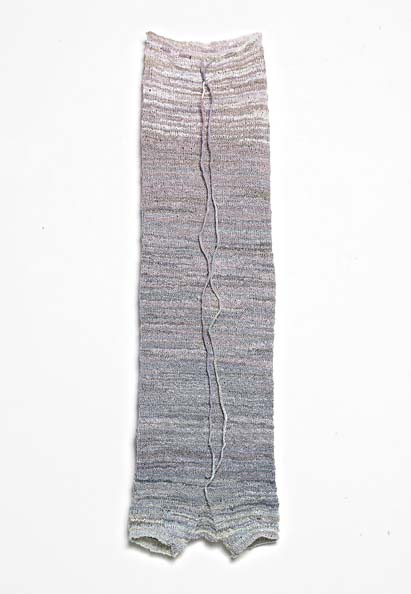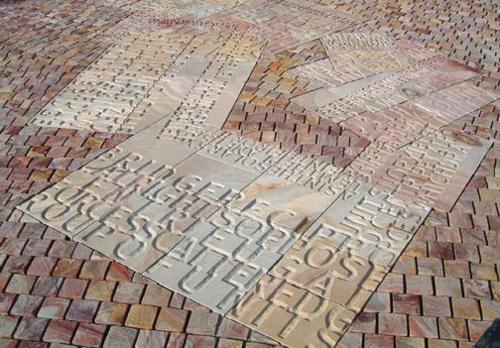
To visit artroom5, a charming domestic-based gallery in the heart of seaside suburbia, one enters via the transitional space of the verandah. Like the gallery itself, the verandah blurs the boundary between inside and out, between private space and the public sphere: so it is entirely apt that artroom5 exhibits work that is engaged in its own boundary blurring. 'Three artists - in the world' collapses the distinction between art and craft, traditional and contemporary practice and professional and domestic concerns. But like artroom5's homely verandah which belies its pristine interior, Sera Waters’ witty embroideries and Irmina Van Niele’s oddly appealing knitted 'garments’, subvert the expected comfort and familiarity associated with traditional domestic crafts.
Knitting and embroidery, whether ‘nanna needlecraft’, textile-led feminist renewal of traditional skills, or part of the indie DIY craft revival, remain resolutely feminine. In her artist’s statement, Waters indicates this lineage referring to the ‘embroidered linens that adorned my grandmother’s home’ and noting that her own work similarly speaks in the ‘decorative language of stitch, using French-knots, silk-shading, beads or black-work’. But like other artists who have previously worked in this medium (Frances Phoenix, Narelle Jubelin, Tracy Emin) she subverts the genre by updating the imagery, replacing traditional floral motifs with the decidedly contemporary subject matter of crime.
Waters staked out her interest in the crime scene - either actual or as entertainment, with previous exhibitions. In Butchering she replaces scattered clues with just two key elements, knives and meat. These motifs are central to the back story of a suburban break-in, stolen steaks and maybe murderous butchers! Exquisitely embroidered, the images of cleavers and chops could be the banal signifiers of the local butchery but their fetishistic enhancement with sparkling sequins and glow-in-the-dark thread suggest otherwise.
More decorative than the cryptic black and white signs of 'A Crooked Lineage' (2008), the elegant knives of 'Butchery: hack and Butchery: de-bone' sit in a bed of opulent black, the meat (in 'Butchering: boneless potroast' or 'Butchering: Two Tender Loins') is surrounded by a pool of melting ice tinged with cool blue and the pink of blood-stained linen. Ironically, perhaps, this use of colour and the blending of ice crystals and doily pattern reference the domestic more than they do drug connections, thereby softening what could have been more ominous.
Colour’s capacity to soften, however, can be deceptive as it is in Van Niele’s garment-like objects. The subtle and muted blues, mauves and greys of 'Premises 3: Good Foundations' give the illusion of warmth and softness; but the reality is that yarn made from shredded plastic bags is cold and uninviting, thus repelling tactility and bodily engagement. Resurrecting the humble or banal object has long been a strategy of the avant-garde but can such a ‘bad object’ as the plastic bag be reclaimed?
Notwithstanding its role in contributing to over-consumption and environmental degradation, the plastic shopping bag has been a remarkably useful item (and as it fast disappears from Adelaide supermarkets we are bound to miss its convenience for carrying, sorting, storing and scrunching up small in the pocket). Van Niele’s work embodies this problematic and ambivalent relationship we have with waste, for in re-using the plastic bag the artist alerts us to our ‘shifting relational sensibilities with rubbish’ forcing us to confront what we’d rather discard and forget.
Unlike other activities of recycling and transformation - whether the plastic bread-wrapper covered coathanger or Third World artifacts made out of first world consumer trash, 'Premises 3: Good Foundations’ droopy drawers serve no practical purpose. As formless, stretched and out-of-shape, sad-sack clothing (evocative reminders of loss, childhood, hand-me-down emotions, maternal fetish or simply saggy old bathers from the past) they are unable to fulfill their original purpose. Signifying waste twice over, these abject objects cannot be put to good use in keeping the body warm, dry, contained or comforted. So Van Niele’s knitted garments remain first and foremost ‘objects to think with’. Neither ornamental nor useful, they are unable to redeem the plastic bag regardless of its (illusory) usefulness.
Anne Kay also makes the plastic bag a feature of her work in 'Picture Tree' using it as a surface on which to screen the image of a stately old gum tree. A slight work, it serves to remind us of what has been lost through urban development. Her works also address environmental concerns via recycling and the use of lo-tech equipment, but lack the subversive power or layers of meaning of 'Premises 3: Good Foundations'.
In blurring the borders between art and craft (that tired old binary) Waters’ and Van Niele’s works offer the viewer a pleasure that is twofold. The pleasure that comes with familiarity, with admiring skill, beauty, and process made visible. Then there is the thrill of seeing tradition disrupted or put to other uses; the pleasure of rupturing, renovating and invigorating traditions rather than simply discarding or denying them.












